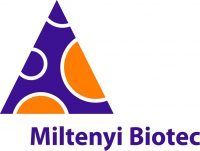CD134 Monoclonal / PE / REA625
Product Details
| Description | Clone REA625 recognizes the CD134 antigen, also known as OX40 receptor, a 50 kDa type I membrane glycoprotein of the tumor necrosis factor/nerve growth factor receptor (TNFR/NGFR) family. OX40 is a secondary costimulatory molecule, which is expressed after 24 to 72 hours following activation. It is expressed on activated mouse T cells and B cells. The OX40 receptor binds to the OX40 ligand (CD252) to provide a costimulatory signal which is independent of CD28. | Additional information: Clone REA625 displays negligible binding to Fc receptors. | | |
|---|---|---|
| Conjugate | PE | |
| Clone | REA625 | |
| Target Species | Mouse | |
| Applications | FC, MICS (MACSima Imaging Cyclic Staining), IF, IHC | |
| Supplier | Miltenyi Biotec | |
| Catalog # | Sign in to view product details, citations, and spectra | |
| Size | ||
| Price | ||
| Antigen | ||
| Host | ||
| Isotype |
About CD134
The protein encoded by this gene is a member of the TNF-receptor superfamily. This receptor has been shown to activate NF-kappaB through its interaction with adaptor proteins TRAF2 and TRAF5. Knockout studies in mice suggested that this receptor promotes the expression of apoptosis inhibitors BCL2 and BCL2lL1/BCL2-XL, and thus suppresses apoptosis. The knockout studies also suggested the roles of this receptor in CD4+ T cell response, as well as in T cell-dependent B cell proliferation and differentiation. [provided by RefSeq, Jul 2008]
The protein encoded by this gene is a member of the TNF-receptor superfamily. This receptor has been shown to activate NF-kappaB through its interaction with adaptor proteins TRAF2 and TRAF5. Knockout studies in mice suggested that this receptor promotes the expression of apoptosis inhibitors BCL2 and BCL2lL1/BCL2-XL, and thus suppresses apoptosis. The knockout studies also suggested the roles of this receptor in CD4+ T cell response, as well as in T cell-dependent B cell proliferation and differentiation. [provided by RefSeq, Jul 2008]
About PE
Phycoerythrin (PE, R-PE) is a red-emitting fluorescent protein-chromophore complex that can be excited the 488-nm blue, 532-nm green, or 561-nm yellow-green laser with increasing efficiency and captured with a 586/14 nm bandpass filter. PE has an excitation peak at 565 nm and an emission peak at 578 nm. PE is 240kD in size and has an extinction coefficient of ~2x10^6 which makes it one of the brightest fluorophores available and a potent donor upon which to build tandem fluorophores with longer Stoke's Shifts.
Phycoerythrin (PE, R-PE) is a red-emitting fluorescent protein-chromophore complex that can be excited the 488-nm blue, 532-nm green, or 561-nm yellow-green laser with increasing efficiency and captured with a 586/14 nm bandpass filter. PE has an excitation peak at 565 nm and an emission peak at 578 nm. PE is 240kD in size and has an extinction coefficient of ~2x10^6 which makes it one of the brightest fluorophores available and a potent donor upon which to build tandem fluorophores with longer Stoke's Shifts.
Experiment Design Tools
Panel Builders
Looking to design a Microscopy or Flow Cytometry experiment?
Validation References
| PMID 8765008 | |
|---|---|
| PMID 10358148 | |
| PMID 11714839 | |
| PMID 25704619 | |
| Additional Sources |

|
Reviews & Ratings
| Reviews |
|---|
Looking for more options?
1016 CD134 antibodies from over 37 suppliers available with over 80 conjugates.
Selected products
0




